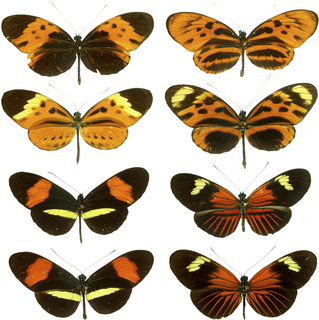
The Heliconiinae, commonly called heliconians or longwings, are a subfamily of the brush-footed butterflies. They can be divided into 45–50 genera and were sometimes treated as a separate family Heliconiidae within the Papilionoidea. The colouration is predominantly reddish and black, and though of varying wing shape, the forewings are always elongated tipwards, hence the common name.

Heliconius charithonia, the zebra longwing or zebra heliconian, is a species of butterfly belonging to the subfamily Heliconiinae of the family Nymphalidae. It was first described by Carl Linnaeus in his 1767 12th edition of Systema Naturae. The boldly striped black and white wing pattern is aposematic, warning off predators.

The Sara longwing is a species of neotropical heliconiid butterfly found from Mexico to the Amazon Basin and southern Brazil. It is a colourful species: the dorsal wing surface is black with a large medial patch of metallic blue that is framed by two bands of white on the forewings. The ventral wing surface is a dull brown to black with muted bands and small red spots on the proximal margin; total wingspan is 55–60 mm.
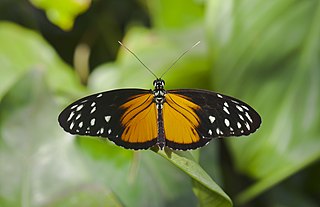
Heliconius hecale, the tiger longwing, Hecale longwing, golden longwing or golden heliconian, is a heliconiid butterfly that occurs from Mexico to the Peruvian Amazon. Hecale, was an old woman who gave shelter to Theseus on his way to capture the Marathonian Bull.

The Bayer Insectarium is an insectarium located within the St. Louis Zoo, in St. Louis, Missouri, United States. David Mason & Associates designed the $4 million, 9,000 square feet (840 m2) facility which opened in 2000. It houses educational exhibits and an active breeding and research facility. The research facility includes a window to the exhibits area and two-way communications so visitors may watch entomologists work and ask them questions. The facility also includes a geodesic flight dome cage, home to numerous rainforest flowers and butterfly species.
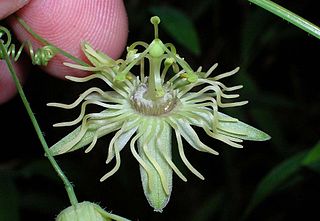
Passiflora lutea, the yellow passionflower, is a flowering plant in the family Passifloraceae, native North America, in the eastern and south-central parts of the United States from Pennsylvania west to Kansas, and south to Florida and Texas. It is the northernmost species of Passiflora, occurring slightly further north than P. incarnata, and tolerant of winter temperatures down to −15 °C, and even −30 °C for short periods.

Heliconius comprises a colorful and widespread genus of brush-footed butterflies commonly known as the longwings or heliconians. This genus is distributed throughout the tropical and subtropical regions of the New World, from South America as far north as the southern United States. The larvae of these butterflies eat passion flower vines (Passifloraceae). Adults exhibit bright wing color patterns which signal their distastefulness to potential predators.
Heliconius nattereri is a species of butterfly in the family Nymphalidae. It is endemic to the Atlantic forest of Brazil.

Heliconius ismenius, the Ismenius tiger or tiger heliconian, is a butterfly of the family Nymphalidae found in Central America and northern South America. They are abundant as far south as Ecuador and Venezuela and as far north as southern Mexico, Guatemala and Belize. H. ismenius are more commonly called the tiger-striped long wing butterfly. H. ismenius's nickname is derived from its long wing structure as well as the beautiful burnt orange and black stripes. Pierre André Latreille, a French zoologist, described Heliconius ismenius in 1817. H. ismenius resembles a number of other butterflies, an example of Müllerian mimicry.

Heliconiini is a tribe of butterflies in the subfamily Heliconiinae, also known as the passion-vine butterflies. This group has roughly 100 species and subspecies distributed primarily in the Neotropics.

Heliconius doris, the Doris longwing or Doris is a species of butterfly in the family Nymphalidae. It is known for being a polymorphic species which participates in various Müllerian mimicry rings throughout Central America and the Amazon rainforest. It is a species of special interest in biological science for the genetic basis and role of polymorphism (biology) in ecology and evolution.
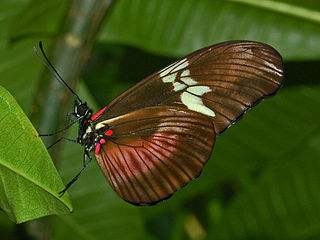
Heliconius hortense, the Mexican longwing, Mexican heliconian or mountain longwing, is a heliconiid butterfly.
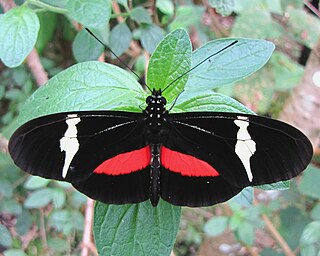
Heliconius clysonymus, the Clysonymus longwing, yellow longwing or montane longwing, is a species of Heliconius butterfly found in Central and South America.
Heliconius hecuba, the Hecuba longwing, is a species of butterfly of the family Nymphalidae. It lives at altitudes ranging from 1000 to 2400 m in cloud forests in the northern Andes from Colombia to Ecuador.

Heliconius antiochus, the Antiochus longwing, is a butterfly of the family Nymphalidae. It was described by Carl Linnaeus in 1767. It is found from Panama to the Amazon region. The habitat consists of riparian forests.
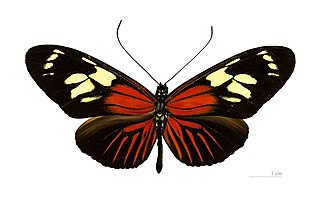
Heliconius burneyi, the Burney's longwing, is a butterfly of the family Nymphalidae. It was described by Jacob Hübner in 1831. It is found in the Amazon basin. The habitat consists of tall forests.

Heliconius ricini, the ricini longwing, is a butterfly of the family Nymphalidae. It was described by Carl Linnaeus in 1758. It is found from Venezuela and Trinidad to the Guianas and northern Brazil. The habitat consists of savanna-type areas.

Heliconius wallacei, the Wallace's longwing, is a butterfly of the family Nymphalidae. It was described by Tryon Reakirt in 1866. It is found from Venezuela and Trinidad to southern Brazil and Peru. The habitat consists of lowland rainforests.

Heliconius telesiphe, the telesiphe longwing, is a butterfly of the family Nymphalidae. It was described by Edward Doubleday in 1847. It is found at mid-elevations in the Andes. Its habitat is cloud forests.
The Spirogyra Butterfly Farm Park Garden,, located in San Francisco de Goicoechea, on the edge of Rio Torres, north of Zoológico Simón Bolívar, in Barrio Amon, Carmen District, San José, Costa Rica, is a butterfly house that houses from 50-60 different species of live butterflies from around the country in a climate-controlled, glass-enclosed habitat.






